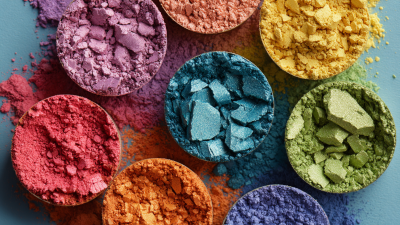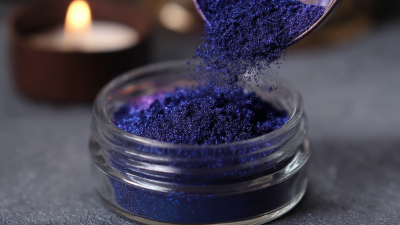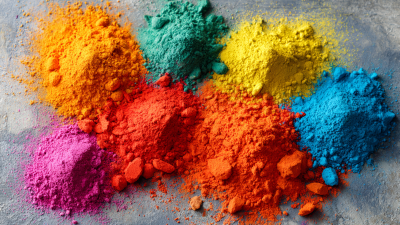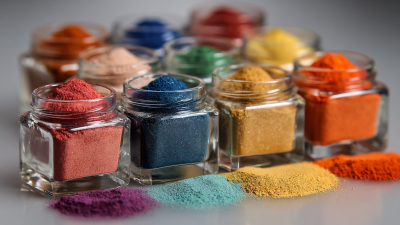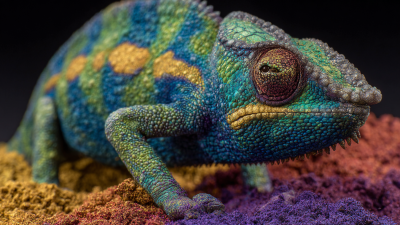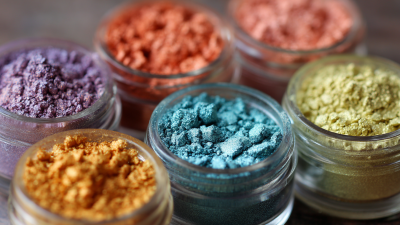As the beauty and crafts industries evolve, the demand for vibrant and unique aesthetic solutions has led to a renewed interest in alternatives to traditional Mica Powder Color. According to a report from the Global Mica Market, the utilization of mica in cosmetics has raised concerns regarding ethical sourcing and environmental impact, pushing companies to explore sustainable options. With an estimated market size of over $2 billion, the search for innovative and eco-friendly substitutes is more critical than ever. Alternatives such as natural clays, plant-based pigments, and even synthetic dyes offer exciting possibilities while addressing environmental and ethical considerations. This blog will delve into top strategies for harnessing these unique alternatives, ensuring that creators and manufacturers can maintain vibrant color palettes without relying solely on mica powder, ultimately contributing to a more sustainable future in cosmetic formulations and artistic endeavors.

As we increasingly seek alternatives to synthetic materials in the beauty industry, plant-based pigments provide a vibrant and eco-friendly solution to conventional mica powder. One such innovative option is Ruby Red, derived from the alkanet root. This natural dye offers a rich red hue that not only enhances aesthetic appeal but also aligns with the growing demand for sustainable beauty products. By embracing these natural pigments, consumers can reduce their environmental impact while enjoying striking colors in their cosmetics.

In addition to Ruby Red, the beauty market is witnessing a surge in inspired natural formulations. With options like high-chroma pigments that shift hues based on their ratios, brands are redefining color palettes. The incorporation of truly organic ingredients plays a critical role in this transformation, encouraging a shift toward cleaner beauty routines. As creators explore the depths of plant-based pigments, they uncover new possibilities that not only benefit the environment but also cater to the health-conscious consumer. This movement towards nature-inspired coloration is not just a trend; it's a revolution in how we perceive and use beauty products.
As the cosmetic industry increasingly seeks sustainable options, innovative synthetic colorants are gaining traction as eco-friendly alternatives to traditional mica powder. According to the market research report by Allied Market Research, the global natural and organic cosmetics market is projected to reach $54.5 billion by 2027, reflecting the growing consumer demand for environmentally responsible products. These synthetic alternatives, crafted from non-toxic ingredients, not only eliminate concerns related to mica mining practices but also provide a fully customizable palette of vibrant shades.
The innovative properties of these synthetic colorants extend beyond their eco-friendliness. A report by Technavio highlights that synthetic colorants are often more stable and longer-lasting than their natural counterparts, ensuring that products maintain their vivid appearance over time. Additionally, these synthetic options have lower production costs due to fewer resource dependencies, enabling brands to offer high-quality, visually appealing products without compromising sustainability. As brands continue to prioritize ethical sourcing and environmental impact, the rise of synthetic colorants represents a significant shift in the quest for vibrant and responsible aesthetic solutions.
When looking to achieve vibrant aesthetics in your projects, the use of clays and earth tones offers a unique alternative to the commonly used mica powders. Clay pigments not only provide rich and natural colors but also enhance texture and depth, making them an ideal choice for artworks, cosmetics, and home interiors. Their organic nature creates a harmonious blend with various design elements, promoting a soothing yet striking visual appeal.
In recent design trends, such as those seen in modern architecture, the integration of earthy tones in both interior and exterior spaces has gained popularity. The use of clay and earthy colors brings warmth and authenticity, creating inviting environments that echo the beauty of nature. For instance, a recent project showcases the brilliance of using these materials to connect vibrant interiors with a Brutalist exterior, demonstrating the versatility and modern edge that clay can bring to aesthetic solutions.
Tips: To effectively incorporate clays and earth tones into your designs, start by selecting a color palette that resonates with nature. Experiment with different textures by mixing clays with other natural materials. Additionally, consider layering your colors for added depth and vibrancy, creating a more dynamic and engaging aesthetic.

Textiles offer an exciting alternative to traditional mica powder colors, providing depth and texture that can enhance the visual appeal of various projects. From intricate embroidery to richly dyed fabrics, these materials can create vibrant aesthetics that are not only unique but also environmentally friendly. Utilizing textiles allows for a broader palette while integrating a tactile element into your designs, making them more engaging and dynamic.
When exploring textile alternatives, consider utilizing fabric scraps or upcycling old garments. This approach not only reduces waste but also opens up a world of color and texture. Additionally, experimenting with natural dyes derived from plants can add organic hues that resonate well with the sustainable movement. Using techniques like tie-dye or painting on fabric can further transform textiles into stunning color sources.
Tip: Don't be afraid to mix different fabrics—try combining cotton, silk, and burlap to create a captivating interplay of textures. Another tip is to layer fabrics in your designs, which can create a multifaceted look that mimics the shimmer of mica powder while adding a unique tactile dimension. By reimagining textiles in this way, you can create striking aesthetic solutions that stand out.
| Alternative Material | Color Range | Texture | Sustainability | Application Areas |
|---|---|---|---|---|
| Natural Dyes | Broad spectrum (Red, Indigo, Yellow) | Soft and Organic | High | Fashion, Home Textiles |
| Beetroot Powder | Deep Red, Pink | Fine and Smooth | Moderate | Crafts, Textiles |
| Activated Charcoal | Black | Granular and Slightly Rough | High | Cosmetics, Textiles |
| Spices (Turmeric, Paprika) | Yellow, Orange, Red | Coarse and Textured | High | Home Textiles, Crafts |
Blending colors is an essential technique for anyone looking to create unique aesthetic outcomes, especially when exploring alternatives to traditional mica powder. By combining various natural pigments like spirulina, turmeric, and beetroot powder, artists can achieve vibrant hues that are not only eye-catching but also eco-friendly.
The key to successful blending lies in understanding how different colors interact. For instance, pairing complementary colors can lead to striking contrasts, while analogous colors create a more harmonious appearance. Experimenting with these combinations opens up a world of possibilities for creating personalized shades that reflect individual styles and preferences.
In addition to color theory, the process of blending itself is equally important. Whether using dry pigments or creating liquid mixtures, gradually incorporating colors allows for better control over the final outcome. Mixing techniques such as wet blending or dry brushing can yield different textures and effects.
A practical tip is to keep a color journal, documenting each combination and the results. This practice not only tracks progress but also serves as inspiration for future projects. Embracing these blending techniques can elevate artistic endeavors, making each piece a true reflection of creativity and innovation.
